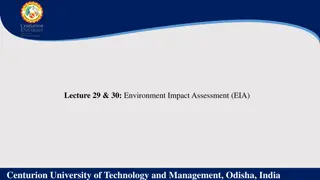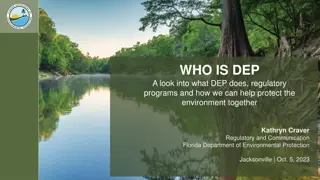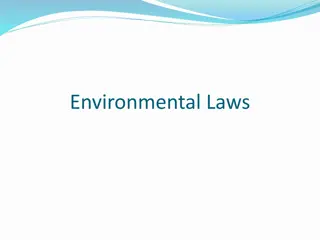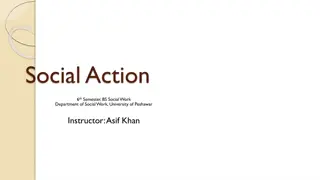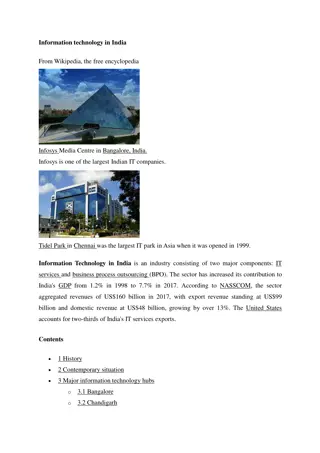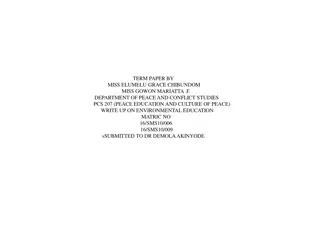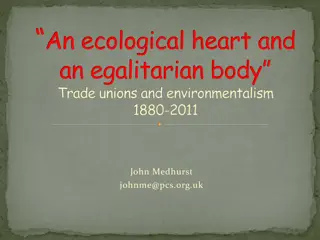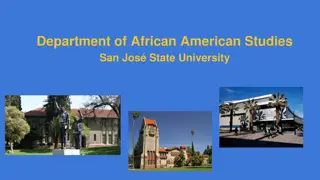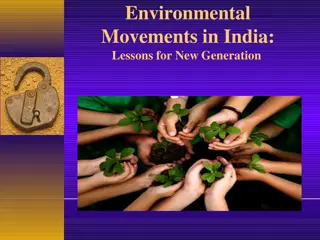Environmental Movements in India - Overview and Major Movements
Environmental movements in India encompass a range of efforts aimed at conserving the environment, managing natural resources sustainably, and advocating for policy changes. From forest conservation to pollution issues, movements like the Bishnoi and Chipko have made significant impacts on environmental protection in India.
Download Presentation

Please find below an Image/Link to download the presentation.
The content on the website is provided AS IS for your information and personal use only. It may not be sold, licensed, or shared on other websites without obtaining consent from the author.If you encounter any issues during the download, it is possible that the publisher has removed the file from their server.
You are allowed to download the files provided on this website for personal or commercial use, subject to the condition that they are used lawfully. All files are the property of their respective owners.
The content on the website is provided AS IS for your information and personal use only. It may not be sold, licensed, or shared on other websites without obtaining consent from the author.
E N D
Presentation Transcript
Environmental Movements in India 1 -Mr. B. M. Birajdar KVM,Wai.
2 Definition An environmental movement can be defined as a social or political movement, for the conservation of environment or for the improvement of the state of the environment The terms green movement or conservation movement are alternatively Environmental movements favour the sustainable management of natural resources. The movements often stress the protection of the environment via changes in public policy Many movements are centred on ecology, health and human rights. Environmental movements range from the highly organized and formally institutionalized ones to the radically informal activities The spatial scope of various environmental movements ranges from being local to national to global.
3 Types of Movements Forest Based Land Degradation Based Water Issues and Dams Pollution Issues Bhopal gas tragedy
4 India : Sites of Major Struggles
5 Bishnoi Movement Year: 1700s; Place: Khejarli, Marwar region, Rajasthan state. Amrita Devi, a female villager could not bear to witness the destruction of both her faith and the village s sacred trees. She hugged the trees and encouraged others to do the same 363 Bishnoi villagers were killed in this movement. The Bishnoi tree martyrs were influenced by the teachings of Guru Maharaj Jambaji, who founded the Bishnoi faith in 1485 and set forth principles forbidding harm to trees and animals The king who came to know about these events rushed to the village and apologized, ordering the soldiers to cease logging operations. Soon afterward, the maharajah designated the Bishnoi state as a protected area, forbidding harm to trees and animals This legislation still exists today in the region
6 Bishnoi Movement
7 Chipko Movement Year: 1973; Place: In Chamoli district and later at Tehri-Garhwal district of Uttarakhand. Leaders: Gaura Devi, Sudesha Devi, Bachni Devi, Sunderlal Bahuguna, Chandi Prasad Bhatt, Govind Singh Rawat, Dhoom Singh Negi, Shamsher Singh Bisht and Ghanasyam Raturi.
8 CHIPKO MOVEMENT
9 Chipko . The women of Advani village of Tehri-Garhwal tied the sacred thread around trunks of trees and they hugged the trees, hence it was called Chipko Movement or hug the tree movement Main demand of the people in these protests was that the benefits of the forests (especially the right to fodder) should go to local people The Chipko movement gathered momentum in 1978 when the women faced police firings and other tortures This became a turning point in the history of eco- development struggles in the region and around the world
10 Chipko Protests
11 What Chipko did
12 Silent Valley Year: 1978; Place: Silent Valley, an evergreen tropical forest in the Palakkad district of Kerala, India. The Kerala Sastra Sahitya Parishad (KSSP) an NGO
13 Silent Valley . The Kerala State Electricity Board (KSEB) proposed a hydroelectric dam across the Kunthipuzha River that runs through Silent Valley In February 1973, the Planning Commission approved the project Many feared that the project would submerge 8.3 sq km of untouched moist evergreen forest Several NGOs led by KSSP, strongly opposed the project and urged the government to abandon it In January 1981, bowing to unrelenting public pressure, Indira Gandhi declared that Silent Valley will be protected In 1985, Prime Minister Rajiv Gandhi formally inaugurated the Silent Valley National Park
14 Appiko Movement Year: 1983; Place: Uttara Kannada and Shimoga districts of Karnataka State Appiko s greatest strengths lie in it being neither driven by a personality nor having been formally institutionalised. However, it does have a facilitator in Pandurang Hegde. He helped launch the movement in 1983. Popularly referred to as Chipko of south
15 Appiko .. The Appiko Movement was locally known as Appiko Chaluvali The locals embraced the trees which were to be felled by contractors of the forest department Appiko movement used various techniques to raise awareness such as foot marches in the interior forest, slide shows, folk dances, street plays etc The second area of the movement s work was to promote afforestation on denuded lands The movement later focused on the rational use of ecosphere through introducing alternative energy resources to reduce pressure on the forest
16 Appiko Protests
17 Narmada Bachao Andolan Year: 1985, Place: Narmada River, which flows through the states of Gujarat, Madhya Pradesh and Maharashtra. Medha Patker, Baba Amte, adivasis, farmers, environmentalists and human rights activists India s oldest environment struggle
19 NBA .. The movement first started as a protest for not providing proper rehabilitation and resettlement for the people who have been displaced by the construction of Sardar Sarovar Dam Later on, the movement turned its focus on the preservation of the environment and the eco- systems of the valley Activists also demanded the height of the dam to be reduced to 88 m from the proposed height of 130m World Bank withdrew from the project
20 NBA . The project is now largely financed by the state governments and market borrowings. The project is expected to be fully completed by 2025. Although not successful, as the dam could not be prevented, the NBA has created an anti-big dam opinion in India and outside It questioned the paradigm of development. As a democratic movement, it followed Gandhian principles
21 NBA Struggle
22 Tehri Dam Struggle Year: 1990 s, Place: Bhagirathi River near Tehri in Uttarakhand. Tehri dam attracted national attention in the 1980s and the 1990s The major objections include, seismic sensitivity of the region, submergence of forest areas along with Tehri town etc. Despite the support from other prominent leaders like Sunderlal Bahuguna, the movement has failed to gather enough popular support at national as well as international levels
23 Localised Movements Ralegaon Siddhi Tarun Bharat Sangh Pani Panchayat Deccan Development Society
24 Strategies of Movements Rural to Urban Local to Global Use of Technology Role of State Role of Media Role of Judiciary Environmental Rights



